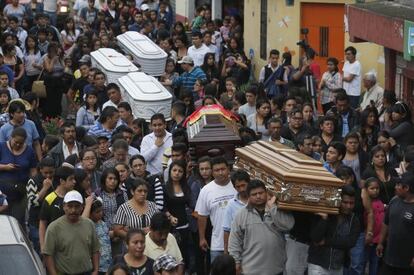Guatemala looks for survivors after mudslide buries entire village
Around 300 people are missing and 149 dead after heavy rains brought debris crashing down

Hopes are running out for the at least 300 people who are still reported missing after a massive mudslide wiped out a small village in Guatemala.
The death toll from last week’s tragedy stands at 149.
The possibility of finding any survivors in the mass and rubble that buried the entire village of El Cambray II on Thursday night have grown slim. El Cambray is part of Santa Catarina Pinula, a town that was also affected.
International guidelines give rescue teams a three-day limit to find people following natural disasters
International guidelines give rescue teams a three-day limit to find people following natural disasters. But digging through the mud and wreckage since Friday, Guatemalan authorities have not found any more people alive.
Defense Minister General Williams Mansilla said on Saturday night that the number of volunteer searchers – around 1,000 – would be drastically reduced the following day so that professional teams and heavy machinery can move in to clear the areas affected by the mudslide.
“We are not ruling out any miracles,” he said, explaining that some of those reported missing may have sought refuge at the homes of family members, neighbors or friends.
Among those helping in the search is an 84-member Mexican team with rescue dogs.
The mudslide occurred after heavy rains sent earth and rock cascading over homes and trapping residents inside.
Tragedies such as this are not new to Guatemala, where 60 percent of residents live in extreme poverty and build make-shift homes on hills and other high-risk areas.
According to statistics, there are 586 registered settlements located in high-risk areas in the poor areas of the capital Guatemala City.
One of the worst tragedies occurred on October 4, 2005 after Hurricane Stan brought mud and debris that buried the entire neighborhood of Panabaj, located near Lake Atitlán, in the western part of the country.
The area was declared uninhabitable after many attempts to find missing people were made. The survivors were moved to safer areas and the old neighborhood is now considered a mass grave, with hundreds of victims believed to be buried there.
English version by Martin Delfín.
Tu suscripción se está usando en otro dispositivo
¿Quieres añadir otro usuario a tu suscripción?
Si continúas leyendo en este dispositivo, no se podrá leer en el otro.
FlechaTu suscripción se está usando en otro dispositivo y solo puedes acceder a EL PAÍS desde un dispositivo a la vez.
Si quieres compartir tu cuenta, cambia tu suscripción a la modalidad Premium, así podrás añadir otro usuario. Cada uno accederá con su propia cuenta de email, lo que os permitirá personalizar vuestra experiencia en EL PAÍS.
¿Tienes una suscripción de empresa? Accede aquí para contratar más cuentas.
En el caso de no saber quién está usando tu cuenta, te recomendamos cambiar tu contraseña aquí.
Si decides continuar compartiendo tu cuenta, este mensaje se mostrará en tu dispositivo y en el de la otra persona que está usando tu cuenta de forma indefinida, afectando a tu experiencia de lectura. Puedes consultar aquí los términos y condiciones de la suscripción digital.
Últimas noticias
The complicated life of Francesca Albanese: A rising figure in Italy but barred from every bank by Trump’s sanctions
How Japan is trying to avert ‘digital defeat’
Half of Scotland is in the hands of 420 property owners
Reinhard Genzel, Nobel laureate in physics: ‘One-minute videos will never give you the truth’
Most viewed
- Pablo Escobar’s hippos: A serious environmental problem, 40 years on
- Why we lost the habit of sleeping in two segments and how that changed our sense of time
- Charles Dubouloz, mountaineering star, retires at 36 with a farewell tour inspired by Walter Bonatti
- Reinhard Genzel, Nobel laureate in physics: ‘One-minute videos will never give you the truth’
- The Florida Keys tourist paradise is besieged by immigration agents: ‘We’ve never seen anything like this’








































